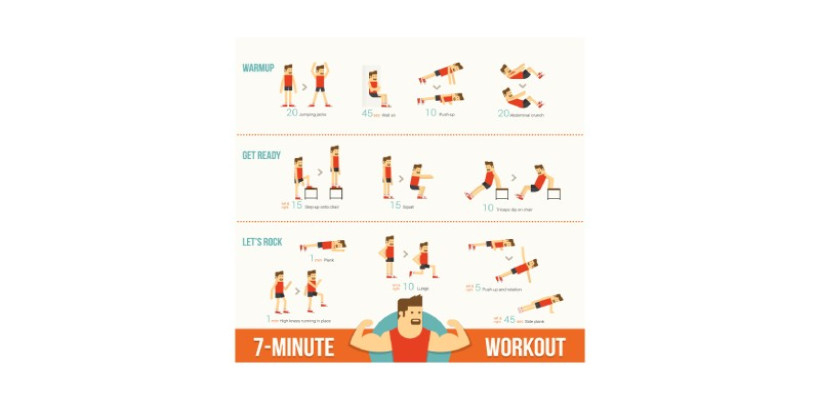Many people associate core strength workouts with the hokey ab routines that have shown on TV infomercials for years.
If you're one of those folks, I don't blame you!
I, too, used to believe that the phrase "core strength" only referred to the abdominal muscles.
However, the image has grown clearer after several years of training (primarily in the sport of powerlifting) and much research.
What is Core Strength?
Contrary to popular belief, a strong core is sustained by more than simply muscles. In reality, the quality and depth of one's breathing are directly tied to core strength.
Many people in our culture just do not breathe properly: they do not take deep belly breaths with a concentration on filling the base/full 360-degree core.
They should be inflating the lower rib cage before the upper chest and lungs are filled with air.
Many people do not breathe deeply, instead only scratching the surface of their breathing capacity by depending solely on upper chest breathing.
How to Breathe
So, before you do any of the exercises below, start with your breath.
Wrap a thick thread (such as a shoe string) around your waist, crossing it over your navel (much like a belt worn high).
Make sure you can fit two fingers between the string and your navel to avoid tying it too tightly and allowing yourself to breathe freely into the belly.
The goal here is to wear the string throughout the day as a tactile reminder to focus your efforts on deep belly breathing.
When you breathe deeply into your belly, you will notice the string tightening around your whole core.
Core Strength for Health
Core strength is an essential part of general health, and we'll look at many workouts that not only improve core strength but also core stability - which is possibly even more important!
15 Essential Core Strength Exercises
1. Kettlebell or Dumbbell Suitcase Carry (“Farmers Walks”)
You'll note that many of these exercises have simple titles, and this one is no exception. It works just as it sounds.
Farmers Walks entail picking up a relatively heavy weight and holding it on each side (left first, then right) for 10-15 paces while walking steadily (focused on core breathing).
You should not walk lopsidedly; instead, have a straight, neutral spine and allow your core to sustain that stability.
2. Lunges
These may be done with or without weights, as well as with or without side bends. If you're using weights, this is a terrific core strength workout to do right after Farmers Walks.
Side bending is accomplished without the use of weight by stretching your arm across and forming a half moon crescent shape during the lunge action - the arm you arch should be on the same side as the leg with its knee on the ground.
3. Glute/Hip-Bridge
This is a basic technique that involves lying down on the ground with your legs shoulder-width apart and lifting your buttocks off the ground to form an arch or "bridge."
This exercise may be done in repeats, which become "Hip Thrusts," or you can maintain the highest position for 3 seconds before returning down.
For a more complex/difficult hold, maintain your arms flat on the ground, or use them to support your lower back for an easier movement.
4. Bird-Dog Exercise
Lean forward and lay your hands on the ground, precisely behind your shoulders (shoulder-width apart) with your fingers pointing front.
Adjust your hands and knees as needed to place your knees precisely behind your hips and your hands directly beneath your shoulders.
Extend your right arm straight forward while simultaneously extending your left leg straight back. Rep on the opposite side, with the left arm straight forward and the right leg straight back.
5. Front Plank
Put your hands shoulder-width apart in a push-up posture and bring your elbows to the ground. That's all! Hold the static posture for as long as you can without your knees contacting the ground, then repeat.
6. Side Plank
This core strength practice is similar to a front plank, only you swivel to either side and rest completely on one elbow or the other.
Perform with the opposite arm straight up in the air or straight/parallel along the side of your body.
7. Goblet Squat
This is a lot of fun! This may be done with a kettlebell (preferably), a dumbbell, or even a hefty book!
Essentially, you're standing with your feet slightly wider than shoulder-width apart and pointing out at a 45-degree angle. Descend into a deep squat and counter-balance with the weight you're carrying.
Before rising, stay in the bottom posture for 7 or more deep breaths.
8. Hanging Leg Raises
This exercise is great for both core strength and stability, as well as general shoulder health.
Maintain a straight back and shoulder line when hanging - be solid and in control throughout the exercise.
Instead of swinging your legs up and down, lift and drop them slowly and deliberately.
9. Barbell Overhead Press
You would not expect overhead pressing to be related to core strength, but it is! A straight line overhead press cannot be performed without first stabilizing and bracing your whole core.
I recommend filming yourself from the side while doing the action and paying attention to whether your bar-path continues in a straight line over your head.
10. Dumbbell Overhead Press
This movement is similar to the barbell overhead press, but it needs greater core and shoulder stability.
11. Dragonfly or Dragon Flag (by Bruce Lee)
This exercise, popularized by martial artist Bruce Lee, needs you to have a decline bench or something similar to hold your full weight.
On the bench, lie flat on your back with your feet closer to the ground (on the decline).
Now, hold the bench behind your neck and raise your legs from the lower position, keeping your upper body stable with your arms and core.
12. Kettlebell Turkish Get Up
This is a difficult activity in which you begin by laying down on the floor and lift the kettlebell above in a straight line in 6 to 10 steps.
Then, as you rise from the floor, maintain that same straight line (keeping the kettlebell overhead).
13. High Bar or Low Bar Back Squat
The high bar squat is the best posture to focus on core stability, and Olympic lifters choose it for that reason.
The low bar squat, on the other hand, will often still increase core strength while allowing for a higher maximum load, and is hence preferred by powerlifters.
14. Deadlift (Sumo or Conventional)
This is my favorite workout since it builds core strength while also challenging one's central nervous system capabilities.
Without going into depth, I recommend watching my video below and visiting my YouTube channel, where I discuss how to efficiently deadlift, squat, and more!
15. Front Squat
Front squats are undoubtedly the greatest approach to improve total core strength since they target both the anterior and posterior muscular chains. They are carried out in one of three methods.
First, cross your arms over and hold the barbell over your chest (on your collarbone), or second, do not cross your arms and maintain your hands shoulder width apart while gripping the bar.
The third method is similar to the second, but if wrist movement is a concern, a pair of straps can be used to keep the bar in place with each hand/wrist.
Conclusion
Core strength should not be evaluated in isolation; rather, it should be considered an intrinsic element of the entire ecosystem that is human physiology.
Core strength is linked to digestion and excretion, and might even be linked to psychological well-being. Many people (including myself) regard our stomach to be a second brain, and if our digestion is in order, so will our intellect.
Try these core strength routines to help your body reach its maximum potential and stay healthy, both physically and emotionally.








Commnets 0